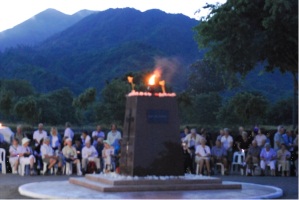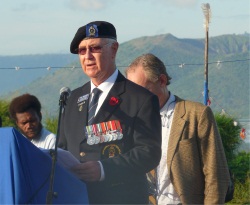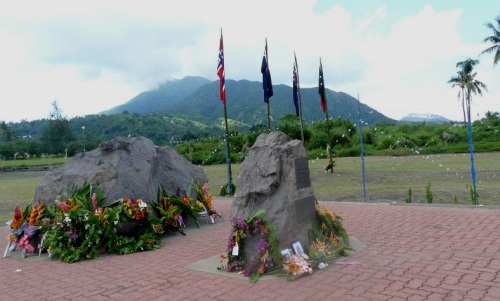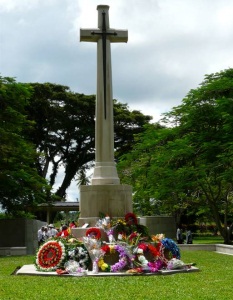
PNGAA Library
Anzac Day 2012 in Rabaul: Bob Cleland

My recent visit to PNG falls naturally into three parts: the cruise from Alotau to Rabaul, Anzac Day in Rabaul, and my return to Goroka after 36 years. I will cover only Anzac Day here to slip it in to the June Une Voce at the last minute. Look for the rest in the September issue.
On the previous Sunday, 22 April, those of us on the cruise had an early breakfast before piling into the Zodiacs to go ashore, before dawn, at Tol. A short walk brought us to the small cairn with plaque erected in memory of the 160 members of the 2/22nd Battalion, Lark Force, who lost their lives at Tol Plantation while prisoners of war of the Japanese Army.
We were soon joined by the local priest who held a short memorial service including a school choir singing two hymns and the Australian National Anthem. Ex-navy octogenarian Frank Lang movingly recited They shall not grow old . . . This simple and emotional little service started our thoughts and emotions building towards Anzac Day.

Rabaul Cenotaph as dawn breaks. Photo: Ally Martell
Several hundred hushed people gathered in the Anzac Day pre-dawn darkness at Rabaul's RSL Cenotaph. The flags of PNG, Australia and New Zealand hung at half mast in the still moist air.
We were welcomed by Tony Avenell, President of the New Guinea Club; we prayed with Deacon Dominic; we heard a Dedication to the Fallen by Major L S Brown of the Australian Defence Staff in Lae; and we were addressed by Phil Ainsworth, President of both the PNGVR Ex-Members Association and also the Rabaul and Montevideo Maru Society.
Phil gave us the historic context of the Anzac legend and extended that to the tragic events of WW II, particularly in Rabaul and New Britain, the very reason we were all there on this 70th anniversary of the several 1942 events.
The Baravon Choir gave us a hymn in their beautiful harmony and as their last notes faded we watched the representatives of several countries reverently lay their official wreaths. The general public followed including a number of PNGAA members and several from the cruise-ship community. The cenotaph base was a sea of colour and many embedded messages with the wreaths and flower sprays spoke of loss and remembrance.
We listened to the haunting notes of the Last Post then bowed our heads in prayer and memory for two minutes. The rousing and stimulating notes of the Reveille, played while the flags were slowly raised to the masthead, sounded as the new dawn broke behind the ridge behind us.
Those who were able walked along a dual lane boulevarde, still covered with loose black pumice, and muddied in places by overnight rain, to the next ceremony at the Montevideo Maru Memorial Stone. This was a little different from the last because the emphasis was on the greatest Australian maritime disaster: the sinking of the Japanese ship with 1053 prisoners' lives lost, most of them Australian.
Phil Ainsworth spoke again, but in greater detail about the personnel, their units, and of the actual sinking. He told us about the memorial, about to be dedicated, standing in the grounds of the Australian War Memorial at Canberra and of the efforts so far in trying to have the site of the sinking declared an Australian War Cemetery. Andrea Williams also spoke about the effect on civilians then living in Rabaul and the islands, and acknowledging those with a direct connection who had made the effort to be present.

Phil Ainsworth addresses the service in memory of those lost on the Montevideo Maru
The Last Post was sounded, we prayed and thought for two minutes of the fallen and of loved ones lost, before the Reveille brought our thoughts back to the present. We watched as representatives of eight nations slowly raised to their mastheads the national flags of Papua New Guinea, Australia, New Zealand, United Kingdom, United States of America, Norway, India and China.

Montevideo Maru memorial
By bus and car we moved to the Rabaul Yacht Club, a temporary structure built on the concrete slab of the former building destroyed in the 1994 volcanic eruption, where we enjoyed a substantial and much-needed breakfast.
Then it was time to tackle the long drive to the Australian War Cemetery at Bitpaka for a third ceremony: this time a more traditional Anzac Day service.
The setting at Bitapaka is very serene and tropical. Over several acres, grave stones lie in straight lines on all sides of the central Cross of Remembrance. Each grave is marked with a low shaped stone on which an engraved bronze plaque shows details of the deceased. Part of the tragedy of war comes to mind when we see the number of graves marked Known only to God.
The service was conventional and simple. Hymns were sung by a quite large school choir. Once again we were impressed by the quality of their voices and their harmonious singing. For me, this was the service that moved me most. There’s a reverence and mystique about a formal cemetery which substantially adds to the formality of an Anzac service.
